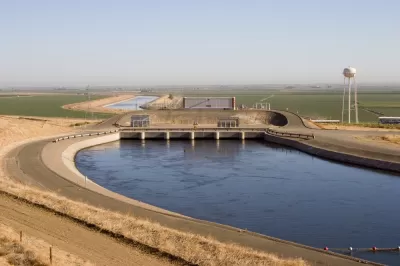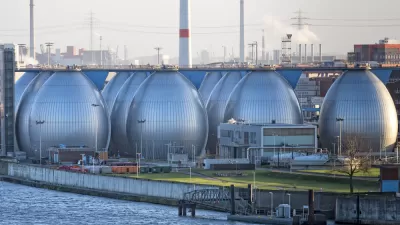California is considering piping recycled potable water directly into people's homes.

Seeking to better manage its water resources throughout the drought, California has commissioned a panel of experts to look into creating regulations for recycled drinking water, produced through a process called direct potable reuse (DPR).
News Deeply describes DPR, which other California cities have called "drought-proof," as a process in which "wastewater is treated for drinking and then piped directly to customers without first being mixed in a reservoir or groundwater aquifer." The site spoke to Jeffrey Mosher of the National Water Research Institute, who heads the panel, about the benefits and challenges of implementing DPR throughout the state. He explains:
In California the drought has put pressure on our traditional or existing supplies, whether it’s surface water or groundwater. Potable reuse, including DPR, provides a lot of advantages in the sense that it’s local – you don’t have to bring it in through a long pipeline or aqueduct.
The panel and a separate group of stakeholders will both submit reports late this month, and the State Water Resources Board will officially decide whether to develop criteria for DPR before the year's end.
FULL STORY: California Eyes Recycling Wastewater for Drinking

Study: Maui’s Plan to Convert Vacation Rentals to Long-Term Housing Could Cause Nearly $1 Billion Economic Loss
The plan would reduce visitor accommodation by 25,% resulting in 1,900 jobs lost.

Alabama: Trump Terminates Settlements for Black Communities Harmed By Raw Sewage
Trump deemed the landmark civil rights agreement “illegal DEI and environmental justice policy.”

Why Should We Subsidize Public Transportation?
Many public transit agencies face financial stress due to rising costs, declining fare revenue, and declining subsidies. Transit advocates must provide a strong business case for increasing public transit funding.

Paris Bike Boom Leads to Steep Drop in Air Pollution
The French city’s air quality has improved dramatically in the past 20 years, coinciding with a growth in cycling.

Why Housing Costs More to Build in California Than in Texas
Hard costs like labor and materials combined with ‘soft’ costs such as permitting make building in the San Francisco Bay Area almost three times as costly as in Texas cities.

San Diego County Sees a Rise in Urban Coyotes
San Diego County experiences a rise in urban coyotes, as sightings become prevalent throughout its urban neighbourhoods and surrounding areas.
Urban Design for Planners 1: Software Tools
This six-course series explores essential urban design concepts using open source software and equips planners with the tools they need to participate fully in the urban design process.
Planning for Universal Design
Learn the tools for implementing Universal Design in planning regulations.
Smith Gee Studio
Alamo Area Metropolitan Planning Organization
City of Santa Clarita
Institute for Housing and Urban Development Studies (IHS)
City of Grandview
Harvard GSD Executive Education
Toledo-Lucas County Plan Commissions
Salt Lake City
NYU Wagner Graduate School of Public Service



























